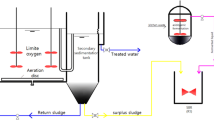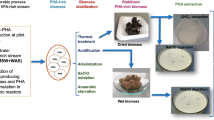Abstract
The production of poly-hydroxyalkanoates (PHA) from the activated sludge subjected to conditions with various oxidationreduction potentials (ORPs) was investigated. By controlling the dissolved oxygen concentration in the cultural media, the ORP were kept at preset levels of −20, −10, 0, and +10 mV. With glucose as the dedicated carbon source, we have demonstrated a correlating relationship with the ORP’s in the culture media to the PHA accumulation rate, the PHA production-yield, cell growth rate, glucose uptakes and 3-hydroxybutyrate to 3-hydroxyvalerate (HB/HV) mole ratios in the PHA copolymers. The highest PHA production yield of 0.26 g/g with HB/HV mole ratio of 8.03 was achieved at +10 mV ORP. We concluded that oxygen plays an important role in PHA accumulation and HB/HV mole ratio activated sludge-to-copolymer PHA conversion process.
Similar content being viewed by others

References
Chua H., Yu P.H.F., Ho L.Y. (1997a). Coupling of waster water treatment with storage polymer production. Appl. Biochem. Biotech., 63: 627–635.
Chua H., Hu W.F., Ho L.Y. (1997b). Recovery of biodegradable polymers from food-processing wasterwater activated sludge system. J. IES. Chem. Eng., 37 (2): 9–13.
Chua H., Yu P.H.F., Lo W. (1998). Accumulation of biodegradable copolyesters of 3-hydroxy-butyrate and 3-hydroxyvalerate inAlcaligenes eutrophus. Appl. Biochem. Biotech., 70–72: 929–935.
Dave H., Ramakrishna C., Desai J.D. (1996). Production of polyhydroxybutyrate by petrochemical activated sludge andBacillus sp. IPCB-403. Indian J. Exp. Biol., 34: 216–219.
Hanada S., Satoh H., Mino T. (2002). Measurement of microorganisms with PHA production capability in activated sludge and its implication in Activated Sludge Model No.3. Water Sci. Technol., 54 (6): 107–113.
Liu K., Chua H., Lo W.H., Lawford H., Yu P.H.F. (2002).Sphaerotilus natans isolated from activated sludge and its production of poly (3-hydroxybutyrate-co-3-hydroxyvalerate). Appl. Biochem. Biotech., 98–100: 1061–1067.
Peddie C.C., Mavinic D.S., Jenkins C.J. (1990). Use of ORP for monitoring and control of aerobic sludge digestion. J. Environ. Eng-ASCE, 116 (3): 461–471.
Satoh H., Iwamoto Y., Mino T., Matsuo T. (1998). Activated sludge as possible source of biodegradable plastic. Water Sci. Technol., 38 (2): 103–109.
Serafim L.S., Lemos P.C., Reis M.A.M. (2002). Change in metabolism of PHA accumulation by activated sludge modifying operating conditions. Water Sci. Technol., 46 (1–2): 353–356.
Takabatake H., Satoh H., Mino T., Matsuo T. (2000). Recovery of biodegradable plastics from activated sludge process. Water Sci. Technol., 42 (3–4): 351–356.
Takabatake H., Satoh H., Mino T., Matsuo T. (2002). PHA (polyhydroxyalkanoate) production potential of activated sludge treating wastewater. Water Sci. Technol., 45 (12): 119–126.
Yu R.F., Liaw S.L., Chang C.N., Lu H.J., Cheng W.Y. (1997). Monitoring and control using on-line ORP on the continuous-flow activated sludge batch reactor system. Water Sci. Technol., 35 (1): 57–66.
Yu P.H.F., Chua H., Huang A.L., Lo W.H., Ho K.P. (1999). Transformation of industrial food wasters into poly- hydroxyalkanoates. Water Sci. Technol., 40 (1): 365–370.
Author information
Authors and Affiliations
Corresponding author
Rights and permissions
About this article
Cite this article
Hu, W., Wang, Y., Hua, F. et al. Synthesis of poly-hydroxyalkanoates from activated sludge under various oxidation-reduction potentials. Ann. Microbiol. 56, 257–260 (2006). https://doi.org/10.1007/BF03175015
Received:
Accepted:
Issue Date:
DOI: https://doi.org/10.1007/BF03175015



